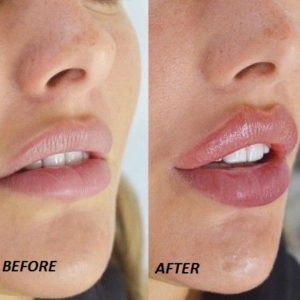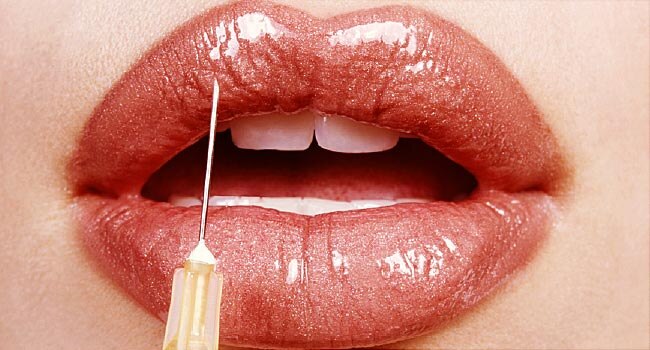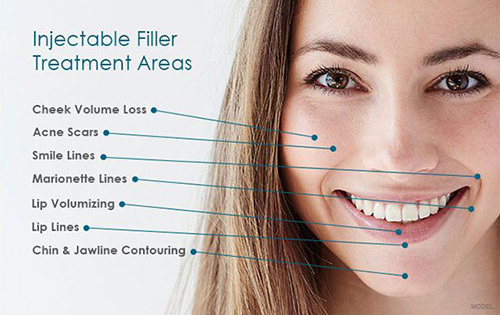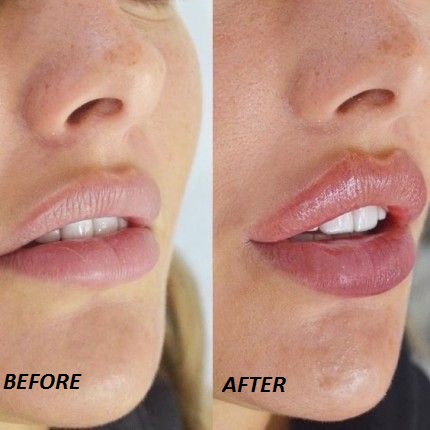F
ull cheeks, smooth skin, plump lips: Some people have them naturally, while others get a little help from their dermatologists with dermal fillers. If you can’t quite tell which category a celebrity or someone you know fits into, well, that’s the point. The latest injectable treatments are easy to get (if not cheap), long lasting, and designed for subtlety. They’re also perfectly safe, provided you’ve done your homework and go to a reputable doctor. If you’re curious about fillers, these are the things to know before getting pumped up.
ermal fillers are gel-like substances that are injected beneath the  skin to restore lost volume, smooth lines and soften creases, or enhance facial contours. More than 1 million men and women annually have choose this popular facial rejuvenation treatment, which can be a cost-effective way to look younger without surgery or downtime.
skin to restore lost volume, smooth lines and soften creases, or enhance facial contours. More than 1 million men and women annually have choose this popular facial rejuvenation treatment, which can be a cost-effective way to look younger without surgery or downtime.
W
hile dermal fillers are casually known as “wrinkle fillers,” they can do  much more than just smooth out wrinkles, although they are excellent at this too! Here are a few of the common issues dermal fillers can help address:
much more than just smooth out wrinkles, although they are excellent at this too! Here are a few of the common issues dermal fillers can help address:
T
here are a variety of FDA approved filler products that cosmetic surgeons use. In general, fillers are categorized by the substance they are made from. A note for your safety: always make sure that you are receiving FDA approved, brand name fillers, which are only available through a licensed physician,
Hyaluronic acid is a naturally occurring substance that is already found in your skin. It helps keep skin plump and hydrated. HA fillers are typically soft and gel-like. The results are temporary, lasting 6 to 12 months or longer before the body gradually and naturally absorbs the particles. Most HA fillers are infused with lidocaine to help minimize discomfort during and after treatment. FDA approved HA fillers include:
Calcium hydroxylapatite is also a naturally occurring substance, found primarily in our bones. When used in a filler, the calcium particles are nearly microscopic and suspended in a smooth gel. The consistency of a CaHA filler is typically thicker than that of a hyaluronic acid filler and typically last longer as well, about 12 months for most patients. Calcium hydroxylapatite is also reported to help stimulate natural collagen production, and it is typically used for deeper lines and wrinkles. FDA approved CaHA fillers include Radiesse®.
Poly-L-lactic acid is a biocompatible (meaning it is safe to use in the body), biodegradable synthetic substance. It has been used for many years in medical devices, such as dissolvable stitches. Poly-L-lactic acid products are technically classified as “collagen stimulators,” as their main mechanism to smooth fine lines is by helping your skin rebuild natural collagen—the filler gel itself dissipates a few days after treatment. Poly-L-lactic acid is typically used to treat deeper facial wrinkles, and results can last more than 2 years. FDA approved Poly-L-lactic acid fillers include Sculptra® Aesthetic.
Polymethylmethacrylate (PMMA) is a synthetic, biocompatible substance that has been used in medicine for much of the last century. In dermal fillers, PMMA takes the form of a “microsphere” or tiny ball, that remains beneath the skin indefinitely to provide continued support. PMMA fillers will also contain collagen, a naturally occurring substance in the skin that provides structure and firmness. FDA approved PMMA fillers include Bellafill® (formerly known as Artefill).
ermal filler injections are non-surgical and typically completed during an office visit. Your initial treatment will begin with a consultation, during which you will meet with your physician to discuss your concerns and goals.
Pre-treatment consultation
During your consultation, your cosmetic surgeon will evaluate your area of concern and review your medical history. While the risks associated with dermal fillers are minimal, you need to fully disclose your medical history prior to treatment, as certain allergies, skin and neurological conditions, or medications can jeopardize your safety or results. For instance, you need to tell your physician if you have been taking NSAIDs (e.g., aspirin, ibuprofen, naproxen) or blood thinners, as these increase the likelihood of bruising.
Just before the actual treatment, the area will be cleaned, and you may be given a topical anesthetic to numb the area prior to injection. Many filler products also contain lidocaine, a mild anesthetic, which is intended to help minimize discomfort during and after your treatment. Your provider will then inject a precise amount of filler strategically beneath the skin.
Depending on the product and the areas treated, you should be able to notice results immediately after receiving filler injections. Some patients experience mild bruising and swelling, but these are temporary and should subside over the days following treatment. You will be able to go back to your normal activities right after treatment, but your physician may ask you to take the day off from exercise or other strenuous activity.
How long the effects of dermal fillers will last depends on the product,  the area of treatment, and the patient. Generally speaking, the denser the product is and the more deeply it is injected, the longer it will last, although this is not a hard and fast rule. To maintain your results, your cosmetic surgeon will simply repeat treatment, adjusting the amount and techniques as necessary to ensure optimal results.
the area of treatment, and the patient. Generally speaking, the denser the product is and the more deeply it is injected, the longer it will last, although this is not a hard and fast rule. To maintain your results, your cosmetic surgeon will simply repeat treatment, adjusting the amount and techniques as necessary to ensure optimal results.
Hyaluronic acid fillers tend to be the most temporary option, and therefore are often recommended for first-time filler patients. These will typically last from 6 to 18 months. Injections to the lips will wear out a little faster than those to the nasolabial folds. Certain HA fillers, such as VOLUMA, are formulated to last longer, but are usually limited to certain areas, such as the cheeks.
Synthetic fillers tend to last longer, as they are not absorbed by the body. They can be a great option for the right patient, but you’ll want to be ready to commit to results that will be there for several years—and choose an experienced, qualified provider whose aesthetic style you like.
Full cheeks, smooth skin, plump lips: Some people have them naturally, while others get a little help from their dermatologists with dermal fillers. If you can’t quite tell which category a celebrity or someone you know fits into, well, that’s the point. The latest injectable treatments are easy to get (if not cheap), long lasting, and designed for subtlety. They’re also perfectly safe, provided you’ve done your homework and go to a reputable doctor. If you’re curious about fillers, these are the things to know before getting pumped up.
Dermal fillers are gel-like substances that are injected beneath the skin to restore lost volume, smooth lines and soften creases, or enhance facial contours. More than 1 million men and women annually have choose this popular facial rejuvenation treatment, which can be a cost-effective way to look younger without surgery or downtime.

While dermal fillers are casually known as “wrinkle fillers,” they can do much more than just smooth out wrinkles, although they are excellent at this too! Here are a few of the common issues dermal fillers can help address:

There are a variety of FDA approved filler products that cosmetic surgeons use. In general, fillers are categorized by the substance they are made from. A note for your safety: always make sure that you are receiving FDA approved, brand name fillers, which are only available through a licensed physician,
Hyaluronic acid is a naturally occurring substance that is already found in your skin. It helps keep skin plump and hydrated. HA fillers are typically soft and gel-like. The results are temporary, lasting 6 to 12 months or longer before the body gradually and naturally absorbs the particles. Most HA fillers are infused with lidocaine to help minimize discomfort during and after treatment. FDA approved HA fillers include:
Calcium hydroxylapatite is also a naturally occurring substance, found primarily in our bones. When used in a filler, the calcium particles are nearly microscopic and suspended in a smooth gel. The consistency of a CaHA filler is typically thicker than that of a hyaluronic acid filler and typically last longer as well, about 12 months for most patients. Calcium hydroxylapatite is also reported to help stimulate natural collagen production, and it is typically used for deeper lines and wrinkles. FDA approved CaHA fillers include Radiesse®.
Poly-L-lactic acid is a biocompatible (meaning it is safe to use in the body), biodegradable synthetic substance. It has been used for many years in medical devices, such as dissolvable stitches. Poly-L-lactic acid products are technically classified as “collagen stimulators,” as their main mechanism to smooth fine lines is by helping your skin rebuild natural collagen—the filler gel itself dissipates a few days after treatment. Poly-L-lactic acid is typically used to treat deeper facial wrinkles, and results can last more than 2 years. FDA approved Poly-L-lactic acid fillers include Sculptra® Aesthetic.
Polymethylmethacrylate (PMMA) is a synthetic, biocompatible substance that has been used in medicine for much of the last century. In dermal fillers, PMMA takes the form of a “microsphere” or tiny ball, that remains beneath the skin indefinitely to provide continued support. PMMA fillers will also contain collagen, a naturally occurring substance in the skin that provides structure and firmness. FDA approved PMMA fillers include Bellafill® (formerly known as Artefill).
Dermal filler injections are non-surgical and typically completed during an office visit. Your initial treatment will begin with a consultation, during which you will meet with your physician to discuss your concerns and goals.
Pre-treatment consultation
During your consultation, your cosmetic surgeon will evaluate your area of concern and review your medical history. While the risks associated with dermal fillers are minimal, you need to fully disclose your medical history prior to treatment, as certain allergies, skin and neurological conditions, or medications can jeopardize your safety or results. For instance, you need to tell your physician if you have been taking NSAIDs (e.g., aspirin, ibuprofen, naproxen) or blood thinners, as these increase the likelihood of bruising.
Just before the actual treatment, the area will be cleaned, and you may be given a topical anesthetic to numb the area prior to injection. Many filler products also contain lidocaine, a mild anesthetic, which is intended to help minimize discomfort during and after your treatment. Your provider will then inject a precise amount of filler strategically beneath the skin.
Depending on the product and the areas treated, you should be able to notice results immediately after receiving filler injections. Some patients experience mild bruising and swelling, but these are temporary and should subside over the days following treatment. You will be able to go back to your normal activities right after treatment, but your physician may ask you to take the day off from exercise or other strenuous activity.
How long the effects of dermal fillers will last depends on the product, the area of treatment, and the patient. Generally speaking, the denser the product is and the more deeply it is injected, the longer it will last, although this is not a hard and fast rule. To maintain your results, your cosmetic surgeon will simply repeat treatment, adjusting the amount and techniques as necessary to ensure optimal results.
Hyaluronic acid fillers tend to be the most temporary option, and therefore are often recommended for first-time filler patients. These will typically last from 6 to 18 months. Injections to the lips will wear out a little faster than those to the nasolabial folds. Certain HA fillers, such as VOLUMA, are formulated to last longer, but are usually limited to certain areas, such as the cheeks.
Synthetic fillers tend to last longer, as they are not absorbed by the body. They can be a great option for the right patient, but you’ll want to be ready to commit to results that will be there for several years—and choose an experienced, qualified provider whose aesthetic style you like.
